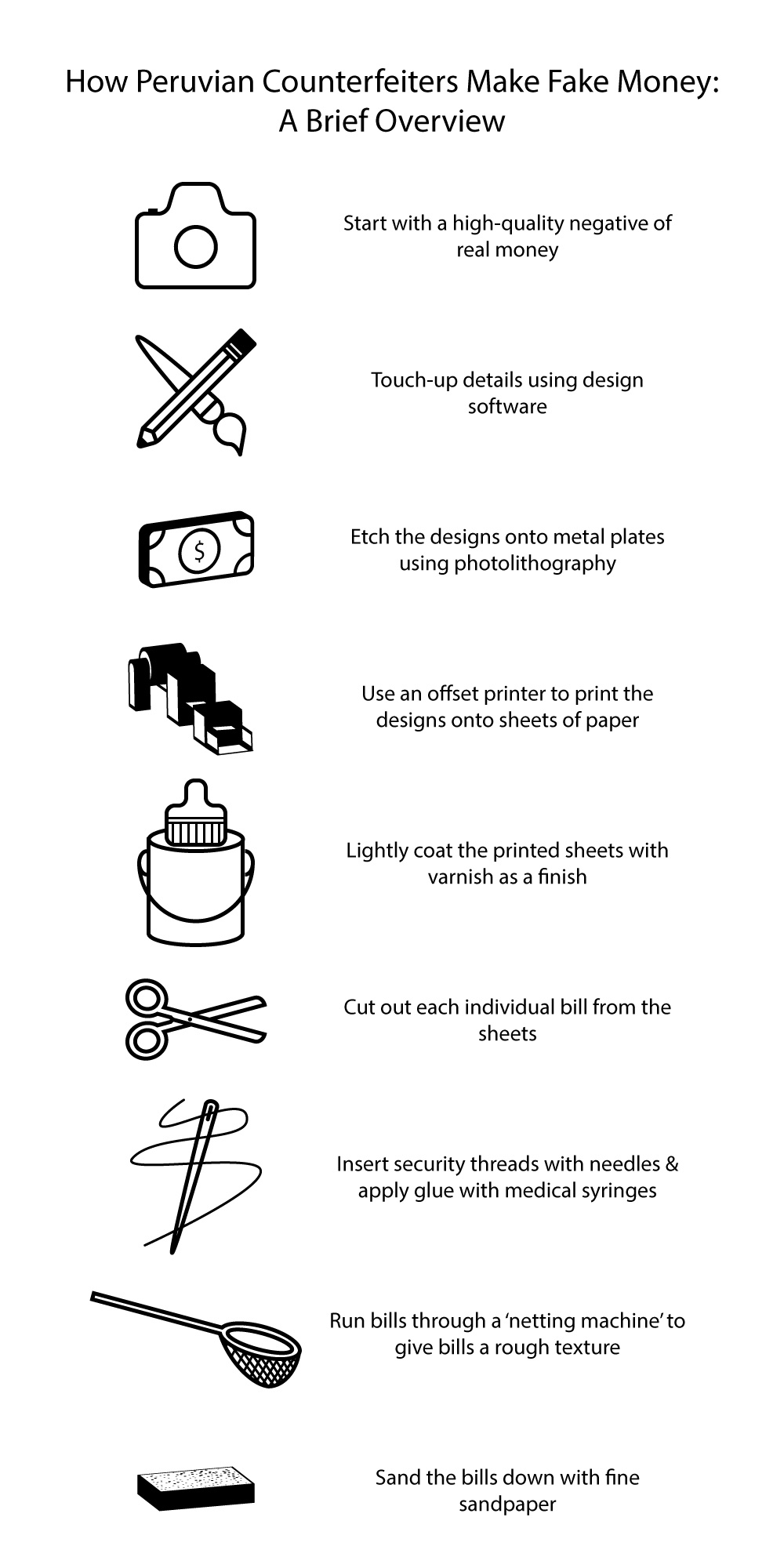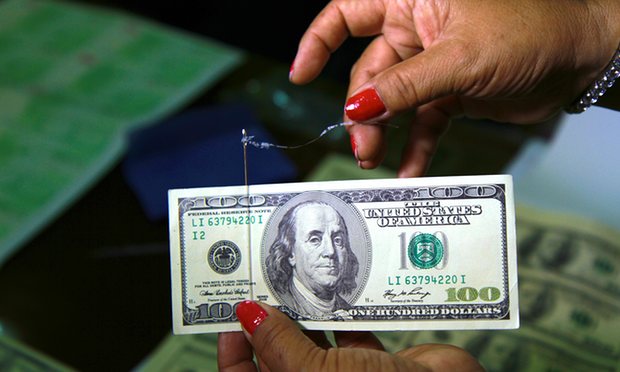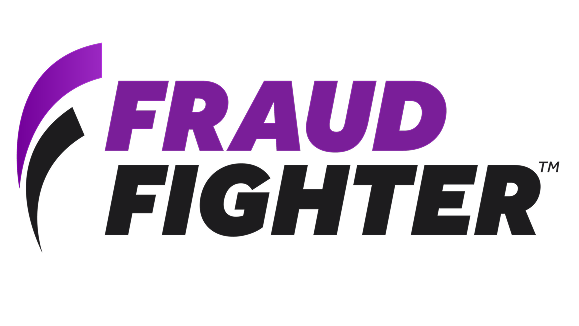
Peru: The Counterfeit Money Production Capital of the World
For decades, Colombia was known as the world leader in counterfeit money production. For the last several years, however, thanks to the collision of a variety of factors, Peru has overtaken Colombia as the counterfeit money production leader of the world. In a nutshell, Peruvian counterfeiters have access to cheaper materials and labor, are subjected to law enforcement and regulations that are, in comparison, more lax and less effective, and, by all accounts, are simply more meticulous when it comes to counterfeit money production than anyone else.
The counterfeit money production trade in Peru has gotten so lucrative that criminals who were once involved in the drug trade, mainly cocaine, are now producing and distributing counterfeit money instead.
In just the past 10 years, about $103 million in Peruvian-produced counterfeit US bills have been seized within the United States; forebodingly, more than half - about $75 million of that total - had been seized since 2009.
Perhaps even more worrisome, this figure, of course, is not representative of the amount of counterfeit money that has actually entered into the United States’ – this is simply the amount of money that has been discovered.
Despite the fact that the US Secret Service has even gone as far as setting up a regional office in Peru in 2012 to work more closely with Peruvian authorities in order to combat the burgeoning counterfeit money trade, there has yet to be a discernible impact on the levels of counterfeit money production in Peru.
How Counterfeit Money is made: A Brief Overview
Before getting deeper into the reasons why Peru has emerged as the world leader for counterfeit money production, there needs to be a brief explanation on how counterfeit money in order to best understand the recent Peruvian emergence.
There are a number of security features built into US currency; how closely counterfeiters are able to correctly copy these security features is what makes a counterfeit bill so valuable.
To put it as simply as possible, counterfeit bills are generally made by starting with a template of a real bill and then transferring the template onto paper. Whether digital or handmade methods are used, what types of materials used to make the counterfeit bills, the level of detail incorporated into each bill – all these decisions are left to each individual counterfeiter and determine just how well their counterfeit bills are able to emulate real bills.

The Peruvians have become the world leaders in making counterfeit money because of just how they’ve optimized the counterfeit money production process. Peruvians are making the world’s best counterfeit bills because they have perfected their production system so much that their fake bills are virtually indistinguishable from genuine bills with the naked eye.
Inexpensive materials and labor
Just like any other business in any other industry, Peruvian counterfeit money producers know that cutting overhead costs is essential. As Walter Escalante, commander of the Peruvian national police’s anti-fraud division, puts it, “They try to make the minimum investment possible. It’s not in their best interest to use expensive materials.” Although they do not use expensive materials to make their fake money, Peruvian counterfeiters have not let that diminish the quality of their work.
A Peruvian counterfeiter, who goes by the alias “Geraldo Chavez”, explained, “The raw materials are very cheap. I will give you an example . . . Here [in Peru], you get the supplies you need at a low cost”, and revealed his general cost and profit structure:
| Raw+material + labor cost per bill (Includes paper, ink, etc.) |
$3-$5 |
| Selling price of 1 $100 counterfeit bill | $20 |
| Profit per counterfeit bill sold | $15-$18 |
As you can see, Chavez will receive at least a 300% return on his investment; with a rate of investment like at that level, it is not hard to see why so much counterfeit money is produced in Peru.
The Legislative and Judiciary Landscape of Peru
Many countries around the world, particularly the United States and European countries, closely monitor the sale, distribution, and use of money printing machinery and technology, especially offset printers, through various anti-counterfeiting divisions. Unfortunately in Peru, this is not the case.
In order to produce counterfeit bills that most resemble real bills, an offset printer is needed. In fact, offset printers are what countries all over the world use to print their currencies. Regular printing is a one-step process: images are printed directly onto the printing surface, such as paper. Offset printing, however, is a two-step process: etched images are inked and pressed onto a rubber blanket, and this rubber blanket is then pressed onto the printing surface.
There is so little regulation on the sale, distribution, and use of money-producing machinery that the counterfeit money industry has become quite capitalistic there: there is actually pretty steep competition amongst counterfeiters in Peru because of how many sellers of well-made counterfeit bills there are. As Chavez, the aforementioned counterfeiter admits, “If you have the best quality, people come to you. If it is second-rate? Doesn’t have the raised lettering? If the paper’s not right? If it doesn’t have the texture? They aren’t going to buy it.”
Not only is the regulation surrounding counterfeit money technologies incredibly lax, but the enforcement of any regulation that does exist is virtually non-existent. Although not all law enforcement officials in Peru are corrupt, rampant corruption is known to exist at nearly all levels of the judiciary and police forces – the arrest and prosecution of counterfeiters are rather rare in light of just how much counterfeit money flows out of Peru.
In order to combat the ineffective enforcement of anti-counterfeiting laws, the US Secret Service established a regional office in Lima in 2012 to work more closely with Peruvian law enforcement officials. Unfortunately, with law enforcement and judiciary corruption playing a role, the presence of the Secret Service has made very little impact on the levels of counterfeit money production in Peru.
In fact, enforcement is so rare that entire Peruvian neighborhoods have been reassembled to become centers for counterfeit money production.
“Entire neighborhoods are famous for being places to buy fake passports, bogus driver’s licenses, invented university degrees, false job contracts, forged housing deeds and practically anything else under the sun.”
These neighborhoods, typically away from the general populace due to the loud machinery needed in counterfeit money production, are notoriously tight-knit and wary of any outsiders. Even with the establishment of a regional office, the Secret Service has not been able to infiltrate, much less, stop counterfeiters in a meaningful way.
The Meticulous Nature of Peruvian Counterfeiters
The biggest factor that sets apart Peruvian counterfeiters from other counterfeiters is not the fact that they have access to cheaper materials and labor. Nor is it the fact that Peru has lax laws and regulation surrounding the counterfeit money trade. Though, of course, both of those factors help.
Peruvians have become, quite simply, more meticulous when it comes to crafting counterfeit bills. In other words, their commitment to detail at all levels of the counterfeit money trade is second to none.
Their attention to detail becomes immediately apparent from the very start of the production process. As mentioned above, in order to counterfeit money, you need a template made from a real bill in order to produce an etching for offset printing as described above. And to make a detailed template, you need a high-quality photograph of real money.
The Peruvians have taken it a step further by using the negatives of high-quality photos; negatives are capable of holding more photographic detail than positives. For details that are not clear or lost on the negatives, the counterfeiters will go back in and add them in by hand. According to Don Brewer, head of the US Secret Service’s anti-counterfeiting division, many counterfeit money factories that he was involved in raiding had “large negative blowups that were used to add detail”.
In addition to having high-quality templates and, therefore, high-quality etchings, Peruvian counterfeiters have put most of their detail efforts into the latter stages of the production process. Most counterfeiters outside of Peru simply use the most technologically-advanced inkjet printer to produce their counterfeit bills and do not do much the bills once they are printed. Peruvian counterfeiters, on the other hand, are known to put the finishing touches on their counterfeit bills by hand.
Chavez, the counterfeiter mentioned above, described the “finishing touches” he puts on his counterfeit bills. During the final steps of his production process, he improves the raised lettering on bills, threads in security strips with a surgical needle, and lightly paints certain areas on the bills with his own homemade flour + glue + water mixture which, when dried, will emulate the texture of a real bill.

Upon inspection of a Peruvian counterfeit, a Secret Service officer at the US Embassy remarked, “It’s a very good note. They use offset, huge machines . . . Once a note is printed they will throw five people (on it) and do little things, little touches that add to the quality.”
Not only have Peruvian counterfeiters incorporated detail-work into almost every part of their production process, but they also have fine-tuned the production process itself. Taking a page out of the Henry Ford playbook, Peruvian counterfeiters have streamlined their production process by separating each process into individual tasks, and assigning one person to each task, shaping them to become masters at that task.
For example, fulfilling an order for $5 million in counterfeit bills will take Chavez and his team of 10-12 people just one week. Chavez broke it down: one person is in charge of running the offset printer, another person is in charge of perfecting the designs, another person is in charge of materials and supplies, another person is responsible for cutting the bills, another person packs the bills, another person is in charge of being the lookout, and so on.
The quality of his counterfeit bills even amazes Chavez himself when he inspects his creations: “These come from the north of Lima, where the factory is. Then they are brought to the center of Lima to enter the black market. They have a texture that is as close as you can get to a real bill. The finishing touches are of the highest quality.”
“More Profitable than Cocaine”
The Peruvian counterfeit money production industry has become so widespread and streamlined that many law enforcement officials, including a top investigator in the Peruvian police’s fraud division, have been reporting that making counterfeit money is more profitable than cocaine. Historically, in the region, cocaine production was more common than counterfeit money production, but as drug regulations tightened, and producing and transporting cocaine began to require more and more overhead costs, criminals have come to realize it’s simply a good business move to make fake money instead.
Even the top investigator admitted, “Counterfeiting is a better business since cocaine production has much higher overhead and transport and processing are far more complicated. Criminal penalties tend to be much higher as well.”
To put it into perspective:
A kilo of cocaine, which is much riskier to not only produce, but export, would only net a profit of about $25,000, but a similar endeavor in the counterfeit money trade could potentially net a whopping profit of about $130,000.
According to Chavez, the average customer would purchase $10,000 - $15,000 in counterfeit bills at a time and would pay 20-25% of the bills’ face value, depending on whether or not they were repeat customers. Chavez claimed that, on average, his group of counterfeiters made about $600,000 per week by producing $3 million - $5 million per week.
In other words, for every $100,000 in counterfeit money they produced, they profited at least $20,000 in real money. It’s no wonder why some Peruvian criminals have found that abandoning the drug trade for the counterfeit money trade has been a great business move.
The Persistence of Counterfeit Money
As skillfully-made Peruvian counterfeit bills are, they are likely only able to bypass the scrutiny of the naked eye and basic fraud prevention measures. Once these bills are put through counterfeit prevention machines at banks, they will be rejected as real money, since these machines use hi-tech countermeasures that are able to pick up subtle security measures hidden in real money that are incredibly hard to replicate in counterfeit money.
In addition to incorporating subtle security measures that are hard to copy, the US Treasury attempts to thwart counterfeiting by releasing new bill designs with changed security measures every now and then; a redesign of the $20 bill was released in 2003 and a redesign of the $100 bill was released in 2013.
In spite of these anti-counterfeiting defenses, it is only a matter of time before counterfeiters reverse engineer each new version of different bills to produce passable counterfeits. The reverse engineering capabilities of counterfeiters is so widely known, at least in the world of currency, that the FBI has an informal pool on when passable counterfeits for new designs will emerge. As Don Brewer admits, “Every time a new design would come out, we would have an informal pool on how soon it would be counterfeited.” It is quite worrisome when the FBI has all but admitted that even they are powerless to stop counterfeiters.
“While police officials struggle to maintain an organized opposition to the flood of fake dollars, the counterfeiters continue to innovate.”
Perhaps the FBI is not incredibly urgent about putting a stop to the counterfeit money trade because the FBI is well aware, as mentioned above, that counterfeit bills tend to get stopped in their tracks when they get to banks. As Brewer notes, “The Peruvian bills never make it beyond the ‘retail’ street level of commerce . . . So in my opinion, it is not a threat to our banking system in that way.”
While it is a relief to hear that counterfeit money gets removed from circulation upon discovery at banks – what about the businesses that unknowingly accepted these counterfeit bills and deposited them into their accounts only to have the banks reject the bills? For these businesses, there is no to remedy this situation; once they have accepted counterfeit bills, any loss, including a rejection of the bills by a bank, is against their bottom line.
It seems the banks are safe, but who’s looking out for the businesses? Not the FBI, who seems content placing the responsibilities of battling counterfeits on those at the front lines of businesses instead. According to a Secret Service agent, “Well-crafted bills are easily introduced into circulation in the United States in retail stores, where clerks are less vigilant.” (Don’t worry, though! FraudFighter has your back with our counterfeit detection machines – the very same kind that banks use to stop fake bills in their tracks.)
It is important to realize that the implications of counterfeiting go beyond just a disruption of American businesses’ financial well-being – counterfeiting can be interpreted by other countries as a sign of instability:
“The dollar stands for the integrity of the US and people everywhere depend on that.”
To make matters even more complicated, Venezuela - a nation a couple of countries to the northeast of Peru – has the world’s highest inflation rate. To put it into perspective, the Venezuelan 10 Bolivar note had a value of $5 five years ago. Today, it has a value of just $0.02. In the eyes of Peruvian counterfeiters, Venezuelan currency is worth much more than the amount of money printed on it: the images on the Venezuelan bills can be bleached off and replaced with the images on US currency. Printing counterfeit money on paper that was once used as real money is incredibly problematic: there’s a better chance that these bills can get past anti-counterfeit measures, even at banks.
The increased use of bills that were once real money is a real threat. Peruvian counterfeiters have relied on ‘bond’ paper to construct their counterfeits; bond paper is commonly used by consumers for a variety of printing activities and can easily disintegrate when wet. However, according to Colonel Segundo Portocarrero, chief of the Peruvian police’s fraud division:
“If they were able to obtain “rag” paper, the cloth type used for banknotes, all bets would be off. The day they get it and perfect the finish a bit more, [their bills] will go undetected.”
And thanks to Venezuela’s inflation rate, Peruvian counterfeiters have access to cheap, already-used-as-currency rag paper.
As long as currency is used as a form of payment, counterfeiters will remain busy producing counterfeit currency. Although law enforcement continues to actively take measures to thwart and arrest counterfeiters, even they have realized the continual futility of their actions: they have resorted to making bets on their constant game of one-upmanship with the counterfeiters– making better and better security measures only to have counterfeiters reverse engineer them to near perfection.
Want to learn how to tell the difference between a real $100 bill and a counterfeit $100 bill with just your naked eye? Download our free $100 Bill Verification Guide to learn about the 5 main security features you should always be on the lookout for:

Does your business conduct cash-heavy transactions and need more help to determine which bills are counterfeit than just your naked eye? Our counterfeit detectors can effectively stop counterfeit cash in its tracks, easily and seamlessly. Click the button below to learn more about how counterfeit detectors can help protect your bottom line.






.png)
